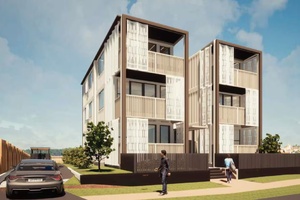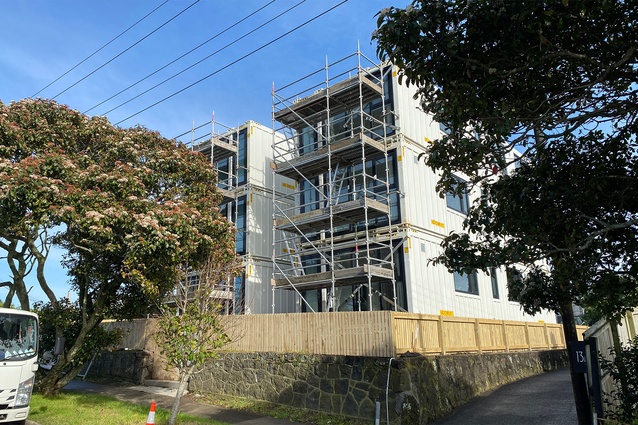Ticking all the boxes
“Surprise new Chinese container style Kāinga Ora apartments for Sandringham,” blared the clickbait headline of a Herald story at the end of May.
Some of the residents of the inner-city Auckland suburb were indeed surprised at how quickly the six new apartments in two three-level blocks were craned into place in just one day.
While some may argue prefabricated building at speed is just what is needed to tackle our housing crisis, some in the street of predominantly California bungalows combined with brick-and-tile single-level units were shocked at what they saw. “We’re starting to look like ghetto cities that we see in other countries,” said one. I guess that means cities with too many people crammed together in impoverished conditions resulting in a high crime rate — US cities, perhaps, like Detroit or New Orleans. Then again, it might just be another case of unabashed NIMBYism — not in my backyard. Or, as The Spinoff headline put it: “‘Container’ homes suddenly uncool now that poor people might live in them”.
In fact, the original headline — or the one picked up by other news outlets such as NewstalkZB – didn’t leave any room for imagination: “‘Like containers’ — new Chinese-built apartments shock Sandringham”. Another resident of the now beleaguered street pointed to the inescapable aesthetic. “They look like those storage containers put on top of each other.” Which was the last thing Tony Frost of Ecotech Construction and Civil, which imported the units from China, wanted: “These are definitely not containers or modified containers,” he said. “Don’t call them container homes. They’re not; they’re bigger than containers for a start.”

But it seems that horse has bolted. “Containers seem to be the new norm for Kāinga Ora”, commented another resident of the newly ghettoised street. True enough. Back in September 2021, the government’s social housing agency announced plans to purchase thousands of prefabricated homes. Kāinga Ora general manager of construction Patrick Dougherty said the main goal of the project was to boost New Zealand’s domestic offsite manufactured capacity and capability. Plus, these homes could be completed on site 40 per cent faster than could traditional builds.
It also wasn’t the first time “Chinese container-style” homes had been disparaged. “Kāinga Ora’s ‘container’-like Rotorua homes at Malfroy and Ranolf shock residents” blared another headline in the Rotorua Daily Post in April. Again, locals had a lot to say: one saying the area now looked like a “trailer park,” and another fearing for the future tenants’ quality of life. Locals also raised concerns over the construction quality, the thermal and acoustic insulation, and the durability of steel used amid the city’s geothermal activity. Kāinga Ora Bay of Plenty regional director Darren Toy tried to allay fears and correct misconceptions. “These are not containers. Because they are made from steel, they may appear alike but that’s where the similarities stop. They are fully functioning modern homes that meet all New Zealand Building Code and healthy home standards.” Toy also pointed out that they come fully insulated with double glazing. “They arrive in New Zealand complete with interiors, including kitchens, bathrooms, floors and paint, which means they can be ready for whānau in need of homes, to move into sooner.”
“What’s so bad about homes that look like storage containers?” asked Madeleine Chapman in her Spinoff commentary. “Nothing. In fact, not long ago and in a different demographic, they were incredibly sought after.” She pointed to the landmark container house built on an impossibly steep site at Ōwhiro Bay, Wellington, made by stacking actual containers. It sparked a bidding war at a recent auction and sold for $745,000.

Anti-state or social or public housing sentiment is nothing new. Back in 2018, writing for Metro, I reported on a group of neighbouring residents in Epsom, gathered to express dismay at the prospect of a redevelopment of adjoining properties on Banff Avenue into a five-storey, 25-unit apartment block. Act MP David Seymour expressed concerns about “social and mental-health issues” and the protesting residents seemed convinced the housing block would lead to an influx of P smokers and other criminals, plus, of course, a terrible destruction of their property values. There was a similar reaction in rural Tuakau, where handwritten notes were delivered to neighbouring letterboxes, warning that low-income people would soon be moving into a newly purchased Housing New Zealand (now Kāinga Ora) property.
The Metro piece was headed: “Gone incognito: How today’s state housing can camouflage against prejudice.” It discussed how social housing had succumbed to the need for density and how existing state housing properties with single dwellings were being replaced to make way for duplex units, terrace houses or apartments. “In the process,” I wrote, “the state house as we once knew it — that recognisable, distinctively ordinary home, mass produced, one-size-fits-all, often weatherboard with casement windows — is long gone. In fact, the state house of today is so incognito you won’t know it’s there.
In contrast, today’s container-style public housing has no camouflage. It’s made itself highly visible, loud and proud. And why not? With some 25,000 people currently on the waiting list for public housing, you can understand why. Meeting such pent-up demand requires action and using offsite manufactured modular units, whether made in New Zealand or China, makes good sense. But don’t call them containers.











